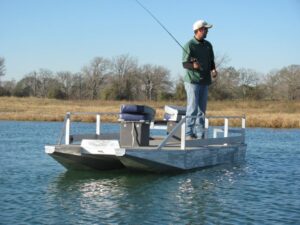By Lochow Ranch
As our ponds pull out of the winter cold and begin to heat up, our gamefish metabolisms rise, and the spring glut is on.
Forage populations generally take a pretty big hit over the winter. Depending on the lake, the spring glut can have a lasting impact on forage and the predators that consume them.
Forage fish are generally smaller fish or crawfish that are the food source for your larger gamefish, such as bass.
Between diving cormorants and pelicans and continual predation by largemouth bass, peak forage populations of the fall season are heavily depressed and must rebound in order for lakes to maintain peak production.
This week, we’ll take a look at some common forage management issues and how to resolve them as part of your fishery management plan.
Goal-Oriented Management
As with most aspects of fishery management, establishing your fishery’s goals is paramount to determining your overarching pond and lake management strategies.
Is your primary target feed-trained bass? Do you mostly care about hybrid stripers? If so, forage fish may not matter a whole lot for your fish. Sure, healthy forage always benefits gamefish, but fish that consume pelleted feed can pretty easily shift their diet away from forage whenever populations are depressed.
If your target species are trophy Florida Largemouth Bass, native non-feed trained bass, or crappie, forage populations are essential.
Let’s take a look at the main forage species for each target gamefish and see how their populations can be managed for the greatest possible impact.
Target Fisheries
Trophy Florida Largemouth Bass
Trophy bass require good forage availability throughout their lives to achieve the outsized proportions for which they are so prized.
Good trophy management requires regular monitoring and rapid intervention if forage populations crash. Generally, these fisheries will rely primarily on bluegill, shad, and crawfish in that order of importance, with additional forage support from redear sunfish, golden shiners, silversides, and in some cases tilapia.
Having some diversity in your forage species helps to provide food for bass as certain populations experience natural fluctuations.
It is important to have good forage diversity in both species and especially size. To ensure all of your bass have plenty of food, careful and regular analysis of small, medium, large, and jumbo-sized forage should be made to determine if your forage is adequately supporting your lake’s bass.
Early in life, bass consume all sorts of fry (recently hatched fish). As they grow their diets shift to small sunfish and fry. In the next stage of life, threadfin shad can really make a huge difference in pushing bass growth. These fish combine with medium sunfish and medium shiners to supply bass to a couple of pounds in weight.
Next your bass will shift to eating large sunfish, threadfin shad, shiners, goldfish, and crawfish. Finally, if all goes well, bass begin to push into the trophy stage where they will continue to consume the latter forage but also begin to take larger meals, which could include jumbo sunfish, gizzard shad, jumbo golden shiners, larger goldfish, trout, and any other large fish they can swallow.
These various forage populations should be supported through supplemental feeding, habitat management, and pond stocking as appropriate.
Non-Feed-Trained Largemouth Bass
Even if you aren’t trying to grow the next world record, home-grown bass fisheries still need adequate forage to develop good populations of healthy fish.
Keep an eye on your forage and develop good populations of fish fry, and small, medium, and large forage.
Most forage is principally helpful in the 1-4” range, with some benefit being had from forage up to 6” in length. In general, forage above 6” in length are too large to serve as much benefit to your average native bass, which generally tops out around 7 pounds in weight.
Threadfin shad are excellent supplemental forage for spring stockings with golden shiners a close second. Golden shiners and goldfish are excellent supplements in the fall.
Once established, bluegill and redear should generally be maintained in perpetuity in well managed fisheries (assuming you don’t have a bunch of hungry cormorants or pelicans land on your lake) and generally won’t need to be restocked.
Crappie
Crappie are notorious for boom and bust reproductive cycles and slow growth.
Care must be taken to help these fish have plenty of food at the right times. Generally, fish fry, silversides, small threadfin shad, small shiners, and small sunfish are paramount to a healthy forage supply.
Large forage will actually remove the food base for these smaller fish, which would depress their numbers and easily result in stunted crappie.
Forage Specific Management
Regardless of your desired outcome, a few key factors must be considered in order for forage to thrive. Let’s take a look at three primary factors, habitat, food, and predation.
Good Habitat
First, habitat must be maintained to provide shelter for some of your forage.
This helps a given lake maintain a breeding population of various forms of forage. Habitat like cover is particularly important for bluegill and redear sunfish. Generally good habitat will involve some beneficial vegetation and some non-living habitat like felled trees or artificial structures. Habitat for open water schooling fish is just going to be that, expanses of open water where they can shelter by schooling together.
Food For Forage
Second, forage food must be plentiful for strong populations.
Sunfish diets can be supplemented with fish food as can that of golden shiners and tilapia. Otherwise, healthy populations of aquatic insects and fish fry are necessary to maintain those populations. Threadfin shad are planktivores and a healthy plankton bloom is essential for these fish to thrive and achieve their potential.
Moderate Predation
While we certainly grow forage to be eaten, we want predation to be commensurate with forage populations.
If the right number of gamefish is maintained, forage numbers will stay high and gamefish will thrive. If predator populations exceed what the forage base can support, forage populations will crash.
 Be sure to conduct the necessary annual harvest of predatory fish to ensure that forage populations thrive. It goes without saying that no fishery can sustainably support predation from huge flocks of avian predators without some supplemental stocking from time to time.
Be sure to conduct the necessary annual harvest of predatory fish to ensure that forage populations thrive. It goes without saying that no fishery can sustainably support predation from huge flocks of avian predators without some supplemental stocking from time to time.
Plan Forage For Your Dream Fishery
Forage matters. Know what forage your preferred gamefish need and make sure you have stocked the right species. Make it a regular part of your fishery management and pond stocking plans.
Assess your lake forage on a regular basis and adjust management strategies to promote healthy forage populations.
Adjust the habitat as needed, keep your forage fed, and limit predation as appropriate.
Your lake will thank you with smiles and your fish will thrive.
Why Choose Lochow Ranch for Pond & Lake Management
Serving Texas, Oklahoma, Arkansas and Louisiana, Lochow Ranch Pond & Lake Management proudly puts more than two decades of experience to work for you. Our team includes biologists, technicians and other professionals with deep expertise in pond and lake management services.
Check us out if you are considering building a lake, looking for pond stocking services, to buy fish for a pond, or getting professional pond management and maintenance or fishery management. Our services include lake design, pond construction, pond renovation, pond water testing, electrofishing, pond stocking, control of pond weeds, and pond liming and fertilizing. Let us help you build your dream pond that will delight your family and friends for generations to come.

Recent Comments